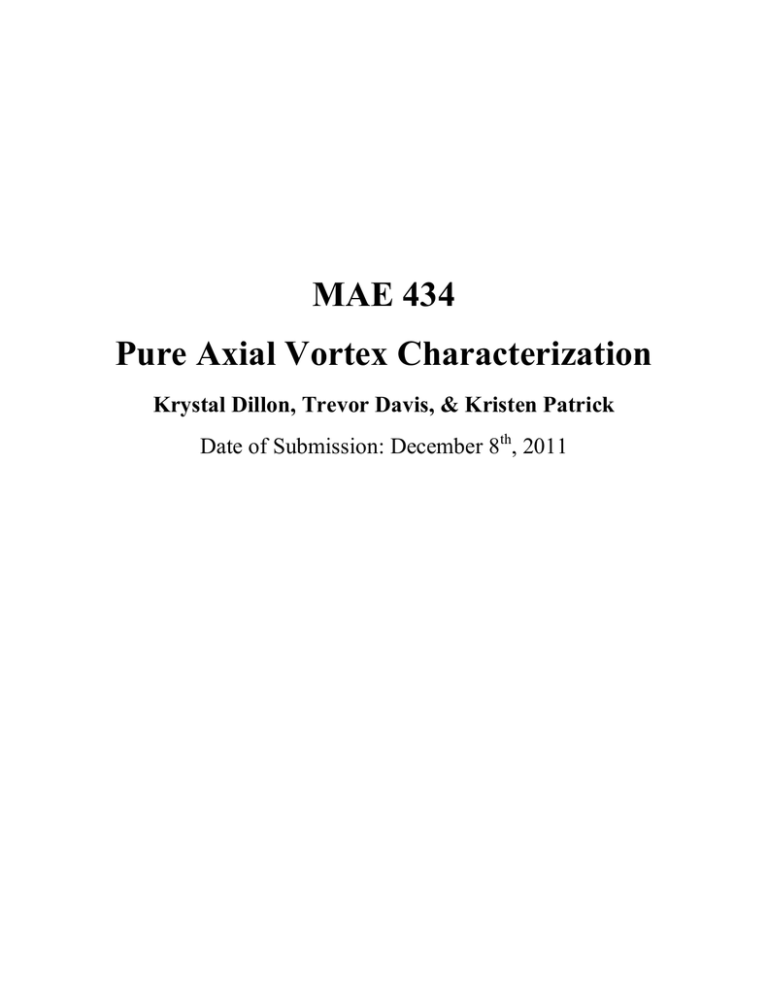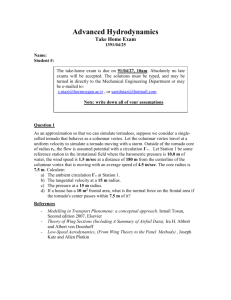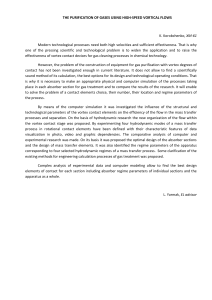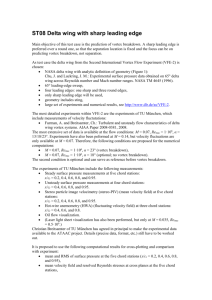MAE 434 Pure Axial Vortex Characterization
advertisement

MAE 434 Pure Axial Vortex Characterization Krystal Dillon, Trevor Davis, & Kristen Patrick Date of Submission: December 8th, 2011 2 Abstract: The purpose of this experiment is to measure the static pressure distribution and the velocity field in the core of a pure axial vortex (Landman). The vortex will be created in the ODU Low Speed Wind tunnel using a custom vortex generator involving two wings. The students will design the vortex generator and assist in the wind tunnel testing. 3 Table of Contents: Introductions…………………………………………………………...………………………….4 Proposed Approach………………………………………………………………………………..5 Organization…………………………………………………………….………………………..13 Cost Consideration……………………………………………………………………………….15 Summary………………………………………………………...……………………………….16 Appendix: List of References……………………………………………………..…………………17 4 Introduction: Vortices are a naturally occurring phenomenon. One such instance is a tornado. Tornados create a pressure drop, which storm chasers constantly use instruments to measure (Edwards, 2011). According to Bernoulli’s theorem, a vortex should cause a reduction in pressure. The largest pressure drop being found in the core of the tornado. The theorem is an equilibrium relation of the dynamic and static pressure of the fluid at two comparative states. In a vortex, there is an increase in the velocity of the fluid flow. It is often difficult to accurately measure the pressure drop in a real tornado. This is due to the fact that often times the instruments are damaged at the time of measurement (Edwards, 2011). Some of the measurements are much larger than that which would be predicted using Bernoulli’s theorem. Therefore, to try and replicate some of the measurements seen from real tornados, this project will attempt to create an axial vortex in a controlled environment. Wing tip vortices off of two wings will be used in a wind tunnel to create the axial vortex (Landman). A pressure transducer will be used to measure the pressure drop across the vortex. From there, a Particle Image Velocimeter may be used to measure and model the velocity of the flow in the vortex. The objective of this project is to create a computer model of the dual wing vortex generator, calculate the amount of load acting on the generator, assist in test design, and assist in testing (Landman). It is anticipated that the benefits of the results can verify that the actual pressure drop that occurs in a vortex is greater than what is predicted by Bernoulli’s theorem. 5 Proposed Approach: The vortex generator works by utilizing the principles of finite length wing aerodynamics. The interaction between two wings at opposing angles of attack is the general cause of the creation of the vortex, but before this can be explained the airflow around one wing needs to be understood. When a wing is subjected to airflow with a positive angle of attack, or the angle between the centerline of the airfoil and the direction of the airflow, a force called lift is applied to the wing. The force is the result of the pressure differences between the top side of the wing and the bottom side. With a positive angle of attack, the pressure on the underside of the wing is high and the pressure on the top side is low. This results in an upward lift. Because this is a wing of finite length, there are airflow effects at the tip of the wing. The air at high pressure under the wing wants to flow towards the low pressure air above the wing, so there is an inherent flow around the tip of the wing from the bottom to the top. (Shown below) Figure 1: The pressure difference between the top and bottom side of the wing results in lift. This flow around the tip causes the air to move in a circular motion. As the freestream airflow moves past the wing (or the wing moves through the free air), the air that gained the circular motion momentum continues to move in circular motion behind the wing, creating what is called a trailing wingtip vortex. 6 The reason that one wing cannot be used as a vortex generator is that a single trailing wingtip vortex is very erratic and does not travel in a uniform axial line behind the wingtip. For this reason, the model being used in the experiment had to be designed to align a vortex in an axial direction behind the model. The vortex generator being used for this experiment has been adapted from a design used in a NASA experiment originally done by Promode R. Bandyopadhyay (Bandyopadhyay, Stead, Ash, 1990). The generator consists of two wings with finite length using the NACA 0012 airfoil profile. These two wings are to be set at opposing yet equal in magnitude angles of attack of 4, 6, 8, and 10 degrees. The “tips” of these two wings are at the center of the model (rather than on the outermost points) and are separated by a flow aligned cylinder. The trailing wingtip vortices produced by these two wings will appear behind the center of the model. Since the two wings are at opposite angles of attack, the direction of the circular flow of each vortex will be the same, creating one strong vortex behind the model. The flow aligned cylinder works to combat the erratic nature of trailing vortices. The trailing vortex initially wraps around the cylinder and is aligned into an axial flow direction that is kept constant behind the cylinder, creating a single pure axial vortex. Effects from the wake of the cylinder are minimal and can be neglected because the wake is dissipated before the vortex is fully formed. The vortex generator is going to be mounted in the high speed test section of the ODU low speed wind tunnel (shown on the following page). 7 Figure 2: The ODU Low Speed Windtunnel The model is 3 feet in length and will be mounted vertically in the test section. The experiment will be run with wind speeds of no more than 40 m/s. The main goal of the experiment is to measure the static pressure distribution inside the vortex created by the model. In order to do this, a cylindrical probe with two self cancelling static pressure taps is to be manufactured and used (Landman). This probe is able to measure static pressure even if the airflow is not linearly aligned up to 20 degrees in either direction. This is because as the airflow strays from the nominal direction, one tap sees an increase in pressure and the other an equal decrease in pressure. Taking the average of the two tap readings will give the static pressure. This probe will be installed in the ODU wind tunnel, which has several pressure measurement acquisition modules with an accurate range for this probe. How this probe 8 will be mounted and moved within the tunnel has not yet been determined. Picture of probe design is shown below. Figure 3: The cylindrical pressure probe that will be used to measure the static pressure distribution. (Landman) To create the vortex we are going to duplicate the wing design from AIAA 90-1625: The Organized Nature of a Turbulent Trailing Vortex (Bandyopadhyay et al.,1990). The design is shown in figure below Figure 4: The wing design used in The Organized Nature of a Turbulent Trailing Vortex report. 9 First we had to find a material that could run through the wing that would be strong enough to handle the forces created from the wing. In Figure () you can see the shear and moment diagrams for how much force the rod will need to handle. 15 Shear (lbs) and Moment (in-lbs) 10 Sh… 5 0 0 3 6 9 12 15 18 21 24 27 30 33 36 -5 -10 -15 Figure 5: The Shear and Moment diagram based on lift. Then we used stress calculations to find that a steel rod could run through the wings and be able to support the load while having a large factor of safety. Then we duplicated the image from the report into Solid Works. We made a few changes from the original design to make it easier to machine and to make it fit our experiment better. The new wing will consist of ten different components. There will be a steel rod that will run through the whole system. There will be a brass tube to support the wings and make it possible for the wings to rotate about the steel rod. The wings are going to be NACA 0012 and will be of foam and will have aluminum ends. The two pieces will be attached together with a fiber glass cloth with resin. The aluminum end will have a hold placed that will be used to set the angle of attack. There will be a flow aligned cylinder made of aluminum that will between the two wings. To mount the wings to the wing tunnel that will be a mounting plate that will be set in the wind tunnel and it will hold the steel bar and have holes to put the wings at the necessary angle of attack. A spring pin will be used 10 between the mountain plate and aluminum wing end to set the angle of attach. Then we will other little necessary parts to make the parts stay together. In Figure () you can see the assembly drawing of apparatus that will be mounted in the wing tunnel. Figure 6: The assembly drawing of the vortex generator. Sample Calculations of the stresses that will be on the beam: Airfoil – 0012 Angle of attack, α = 10° Span, b =17.5 in 11 Chord, c = 4 in Thickness, t = (12%)*c = (0.12)*(4 in) = 0.48 in ρ = 0.00237 lbs*s2/ft4 Vmax = 40 m/sec = 1.3123(102) ft/sec Aspect Ratio, AR = Note: CL = (CLα)*(α) Where Where (Dynamic Pressure) Solve for L to get the amount of Lift acting on the wing. Steel Rod: d d = 0.3125 in 12 For Angle of Attack, α = 10°, where L = 7.5 lbf and Mmax = 16.4063 lbf*in: For Carbon 1144 Stressproof Cold Drawn Round (Steel Rod) Sy = 100,000 psi (www.onlinemetals.com) Factor of safety: Brass Tube: OD ID OD = 0.375 in ID = 0.315 in For Angle of Attack, α = 10°, where L = 7.5 lbf and Mmax = 16.4063 lbf*in: For Brass Tube Brass (C260 Cartridge Brass): Sy = 52,200 psi (www.onlinemetals.com) Factor of safety: 13 Organization: The majority of tasks will be a collaboration between all team members. The team leader of the project is Trevor Davis. The Solidworks (Computer Modeling) specialist is Krystal Dillon. The stress calculations portion is being led by Kristen Patrick. Bellow can be found a table of the task list. The Gantt Chart (or timeline of the project) can also be found below in figures 4, 5, and 6. Task: Duration: Start Time: Research & Planning 21 days Modeling 14 days Stress Calculations Ordering, Manufacturing, & Receiving Material Assembly Design and Manufacture Pressure Probe Testing Analysis & Report Writing 14 days 10/20/2011 8:00 11/18/2011 8:00 11/18/2011 8:00 27 days 10 days 25 days 30 days 17 days 12/8/2011 8:00 1/16/2012 8:00 1/9/2012 8:00 2/13/2012 8:00 3/26/2012 8:00 Table 1: Task List Figure 1: Part 1 of the Current Gantt Chart (Current as of 12/8/11) End Time: 11/17/2011 17:00 12/7/2011 17:00 12/7/2011 17:00 1/13/2012 17:00 1/27/2012 17:00 2/10/2012 17:00 3/23/2012 17:00 4/17/2012 17:00 14 Figure 2: Part 2 of the Current Gantt Chart (Current as of 12/8/11) Figure 3: Part 3 of the Current Gantt Chart (Current as of 12/8/11) 15 Cost Consideration: Below is an itemized budget of the materials that must be purchased for the project. Note there is a miscellaneous section that is to account for shipping, taxes, and unknown expenditures that may occur while completing the project. Item: Quantity: Unit Price: NACA 0012 Wing (4 in Chord, 17.5 in Span) Brass Tube (60 in Length, 0.375 in OD, 0.315 in ID) Carbon 1144 Stressproof Cold Drawn Round 0.3125" Diameter, 48" Length (Steel Rod) Aluminum 2011-T3 Bare Cold Finish Round 0.5" D, 24 in Length Aluminum 6061-T651 Bare Plate (8 in x 8 in sheet, 0.5 in thick) 18-8 Stainless Steel Key Stock Undersized (1/8" x 1/8", 12" Length) One-Piece Clamp-on Shaft Collar Black-Oxide Steel, 5/16" Bore, 11/16" OD, 5/16" W 18-8 Stainless Steel Slotted Spring Pin 1/8" Diameter, 1/2" Length, Packs of 100 Total: 2 $45.00 $90.00 1 $7.99 $7.99 1 $4.31 $4.31 1 $4.82 $4.82 1 $19.76 $19.76 1 $2.08 $2.08 2 $1.74 $3.48 1 $4.48 $4.48 Miscellaneous (Shipping, Tax, etc.) $30.00 Total: Table 2: Budget (www.McMaster.com; www.Onlinemetals.com) $166.92 16 Summary: In order to create a pure axial vortex, a vortex generator design has been adapted for the ODU Low Speed Wind Tunnel and is in the manufacturing process due to be completed by the start of the Spring 2012 semester. The current focus of the Senior Design students' experiment is to assemble the model, manufacture a pressure probe, and run wind tunnel tests so that pressure data can be analyzed by the end of the semester. 17 Appendix: References: Edwards, R. (2011, October 29). The Online Tornado FAQ. Retrieved December 4, 2011, from http://www.spc.noaa.gov/faq/tornado/ Landman, D., Pure Axial Vortex Characterization. Retrieved November 30, 2011, from http://www.mem.odu.edu/ugrad/designproject_pure_axial_vortex.pdf McMaster-Carr. Retrieved December 4, 2011, from www.mcmaster.com OnlineMetals.com and plastics too!. Retrieved December 4, 2011, from www.onlinemetals.com Bandyopadhyay, P., Stead, D., and Ash, R. AIAA 90-1625: The Organized Nature of a Turbulent Trailing Vortex. 1990.




